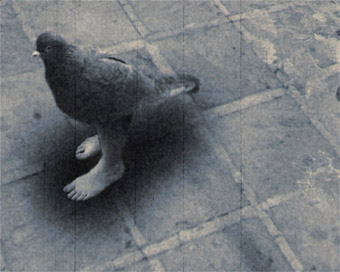 |
Carl Stevenson's Contamination |
The festival opened with a showcase of early Russian films demonstrating what makes for terrific animation: deeply textured plots, inventive characterisation and satirical twists. It was the perfect way to start MIAF—an example of what can be achieved with original ideas even on a slender budget. The Estonian Panorama proved another highlight, despite that country’s small industry of only 2 animation studios. Priit Tender’s masterful Gravitation centred on a surreal road trip, playing with conventional perceptions of story and of the film frame itself. Tender’s Mont Blanc overwhelmed with vivid images of an insurmountable mountain of suitcases, ominous ravens and menacing life-size pliers chasing the protagonist along a train of faceless workers. Much of the beauty of the Estonian films lies in what is not overtly stated, leaving interpretation wide open and creating an atmosphere of weird splendour without compromising the narrative. 3D technology is used minimally to enhance the animation rather than demanding to be noticed for its own sake.
The Priit Parn Retrospective showed the Estonian filmmaker to be a master of the form. The Night of the Carrots explored, via a labyrinthine hotel, our obsession with celebrity and the fear of computers taking over everyday life. The closing scene, in which evil rabbits perform voodoo on their carrots to control the world, was a festival highlight!
Films displaying the level of complexity evident in the Estonian works can only be achieved with sustained development involving government or private backing, something generally lacking in the Australian context. Of the local films, the widely discussed Harvie Krumpet (Adam Elliot, RT57, p19) sustained its story and clever characterisation over its half hour length, and Jonathan Nix did in Hello (RT58, p22) what few other animators are prepared to do, allowing the mood and theme of the soundtrack to lead the story. Generally, however, the offerings of the Australian Panorama came across as simplistic. The constant and gratuitous use of 3D computer animation showed that no amount of money spent on technique can make up for an ordinary script. Flat by Sebastian Danta was promising, with a scratchy illustrative approach and entertaining peek into the lives of flat-dwellers, but the computer technology applied to eyeballs and exteriors served merely to detract from any stylistic cohesion. Placement by Bill Chen was a wonderful futuristic story about human cloning, combining animation seamlessly with live action. But only Fog Eyes by Hamish Koci pointed towards a whole new strain of contemporary Australian animation being done with Flash.
A mix of media characterised the output of many films in the International Program. It’s Like That by the Southern Ladies Animation Group from Melbourne deservedly won the prize for best Australian animation. Using real-life recordings of refugee children in detention, the group deftly combined stop-motion knitted characters, Flash animation and cell drawings to create a deeply moving film about life behind barbed wire. Contamination (Carl Stevenson) created an eerie, unsettling atmosphere by merging animals with human parts and vice-versa. The Dave Brubeck soundtrack and frenzied squiggles of Cameras Take Five (Steven Woloshen) could have been created by the Canandian master Norman McLaren himself. I was pleased to see that an elemental technique like scratch-on-film could still get an enthusiastic reaction from the audience.
With only 6 days of screenings, it would be difficult for MIAF to give a total snapshot of current world animation, however the dearth of Asian content was a glaring oversight that many patrons commented upon. The main impression left by the festival was the disparity in quality between the Australian and international programs. Are we still at an exploratory stage? Is the problem a lack of funding, or do we need to direct our resources in different ways? Although the local offerings at MIAF were uneven, films such as Hello and It’s Like That indicate the immense, if largely unrealised potential of Australian animation.
Melbourne International Animation Festival 2004, Australian Centre for the Moving Image, Melbourne, June 22-27
RealTime issue #62 Aug-Sept 2004 pg. 22
© Rebecca L. Stewart; for permission to reproduce apply to [email protected]








 back
back